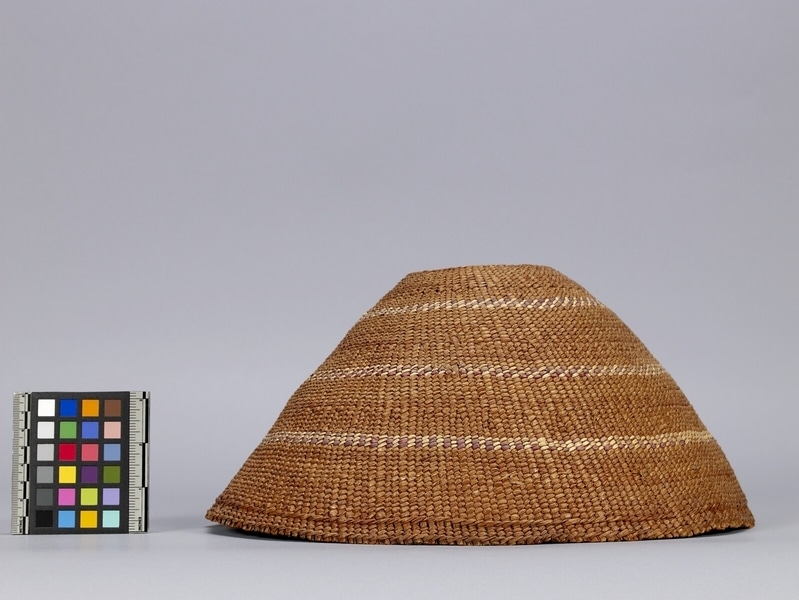Hat Item Number: A3724 from the MOA: University of British Columbia



Description
Dome-shaped, double-woven, cedar bark basketry hat. The top is slightly indented with plaiting in the centre. The plaiting is outlined with double strand twining, after which the warps are split and the twining becomes much finer. The rim, at the top, is outlined with one row of triple strand twining. Triple strand twining is also used along the bottom rim, above which is two rows of double strand twining and then another of triple strand. The rest of the hat is double strand twining. The hat is decorated with three rings of grass wefts, each ring being three rows wide, and alternating purple and the natural yellow colour. The hat is lined with cedar bark that is plaited at the top, and then twined using two strands. The hat band is both twined and plaited.
History Of Use
Dome-shaped double woven hats, like this one, were worn as rain gear. A hat band inside the hat was used to fit the hat to the crown of the head, and to keep the sides of the hat away from the wearer's head - thereby creating an effective rain barrier.
Specific Techniques
Two strand twining was the predominant method used for this hat. In two strand twining one weft (horizontal strand) passes over a warp (vertical strand) and under the next, while the a second strand passes under and then over the next warp. In this manner the wefts are always in opposition to each other. Three strand twining is also used minimally on the exterior. The hat is double woven, which means that an inner and outer hat were woven and attached at their rims. The hat band was both twined and plaited.
Narrative
Dome-shaped rain hats were made along the Southern Coast of British Columbia and in adjacent areas of Washington State. They are associated with both the Nuu-chah-nulth and Coast Salish people. These types of hats are often double woven, which means that the inside of the hat may appear quite different in colour and appearance from the outside. This hat is very similar in appearance to two Nuu-chah-nulth hats in the collections of the Royal British Columbia Museum (11447 and 4659). The former (11447) is identical in style and use of colour, which suggests that they may have been made by the same person.
Cultural Context
rain hat; basketry
Item History
- Made in Vancouver Island, British Columbia, Canada
- Collected in British Columbia, Canada
- Owned by Ross A. Brooks
- Owned by Mabel Orr Brooks before July 20, 1951
- Received from Mabel Orr Brooks (Seller) and Museum Purchase (Funding source) on July 20, 1951
What
- Name
- Hat
- Identification Number
- A3724
- Type of Item
- hat
- Material
- cedar bark, grass and aniline dye
- Manufacturing Technique
- twined, woven, dyed, split and plaited
- Overall
- height 16.0 cm, diameter 33.2 cm
Who
- Culture
- Nuu-chah-nulth
- Previous Owner
- Ross A. Brooks and Mabel Orr Brooks
- Received from
- Mabel Orr Brooks (Seller) and Museum Purchase (Funding source)
Where
- Holding Institution
- MOA: University of British Columbia
- Made in
- Vancouver Island, British Columbia, Canada
- Collected in
- British Columbia, Canada
When
- Ownership Date
- before July 20, 1951
- Acquisition Date
- on July 20, 1951
Other
- Item Classes
- basketry
- Condition
- good
- Accession Number
- 1865/0001